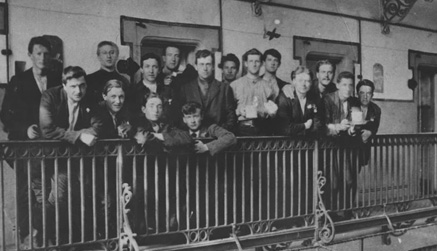Military Service (1916 - 1921) Pensions Collection
Research project: Internment in 1916
“That tired Frongoch feeling”
Themes: Internment Sub-themes:
Subject: History Language: English
Estimated Number of Classes: 2
Toolkit: Projector,Internet Connection,Computer Lab

Abstract:
This lesson plan will introduce students to the topic of Irish internment in the aftermath of the Easter Rising in 1916. The lesson’s aim is to teach students how to use and engage with online primary sources for research purposes and how to locate digitised material in a discerning way. The lesson will familiarise students with militaryarchives.ie and letters1916.ie. Students will then examine digitised primary sources, interrogate images, research independently and report back their findings to the class concerning the Irish experience of internment after the Easter Rising, and key locations.
Lesson Aims/Objectives:
a. To introduce students to the concept of internment
b. To engage students in analysis of primary source material
c. To familiarise students with sites such as militaryarchives.ie, http://letters1916.ie and the bureau of military history collection page within militaryarchives.ie
d. To equip students with a better understanding of internment after the Easter Rising and internees’ experience of Frongoch and Stafford Gaol in particular
Advanced Preparation Required:
a. Teachers should ensure that the Military Archives website (which includes the Bureau of Military History collection pages) and the http://letters1916.ie collection are whitelisted for the classroom and that they are familiar with the navigation of the sites.
b. The teacher presents specific queries for students to consider about the image taken in Stafford Jail:
i. https://photogallery.militaryarchives.ie/displayimage.php?album=47&pid=436#top_display_media(see Material Needed 10.‘a’, ‘d’ and ‘e’). The materials provided will assist in providing satisfactory responses to the queries posed.
ii. Queries
- Can you identify the person marked “x”?
- When and where was the photograph taken?
- What does this photo tell you about the conditions that these men were kept in? (t eacher- note plain clothes of internees, apparent opportunity to congregate and food and drink items held by a number of internees)
- Why is there a wire mesh beneath the prisoners?
Methodology:
a. The teacher should explain the concept of interment after the Rising to the class. Areas covered could include: who was interned? where were they interned? why were they interned? how are internees different from other prisoners? Helpful sources include the Sinn Fein Rebellion handbook (list of men and women deported following 1916 Rising and destination gaols and prisons are listed) - see Material Needed 10.‘c’.
b. The teacher should hand out the question exercise relating to the Stafford Gaol image (see Materials Needed 10. ‘a’, ‘d’ and ‘e’ ).
c. Following on, the teacher should demonstrate a search of Letters of 1916 and Military Archives (including Bureau of Military History collection) sites on projector. The teacher may find it useful to use keyword ‘Frongoch’ in the Subject Information field of the MIlitary Service Pensions collection, or keyword ‘Stafford’ in the Bureau of Military History. Other sites of internment could also be used to support a keyword search of both online collections. The teacher could also ask a core group of students to focus solely on Frongoch letters contained in http://letters1916.ie
d. The search results should return a number of names and highlight sources. Students are assigned a name and asked to find out more information as homework.
e. In the following class, the students should then make individual 1-2 minute presentations about their chosen individual to be presented to the class during the lesson if there is time, or as part of the following lesson. The presentation should include an interesting fact about what led the individual to be interned and an interesting fact about the individual's time in an internment camp.
Assessment:
a. The students will be asked to demonstrate where they found their particular person (what source) and explain how they decided which pieces of information to focus on.
b. Assessment of the student presentations, eg. delivery, accuracy etc.
Funded/developed by
Developed by The Letters of 1916 Project, The Military Archives, An Foras Feasa and The Humanities Institute at Maynooth University. Funded by the Department of Education and Skills and the Irish Research Council.
 <200b>img-responsive">
<200b>img-responsive"> <200b>img-responsive pull-right">
<200b>img-responsive pull-right">

